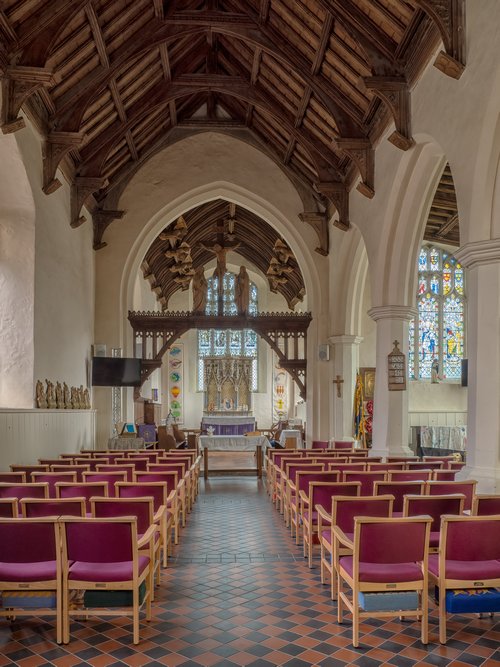St. Mary's Church - a history and guide
Welcome to this ancient and beautiful church, which Capel folk have tended and cherished for maybe 900 years and which today is still in active use for Christian worship, witness and hospitality – the purpose for which it was built.
Those whose Spiritual Home it is are glad that you have come to visit. Please make yourself thoroughly at home here and enjoy exploring the craftsmanship from many periods (including our own) to be discovered inside and outside the building.
Visitors soon become very much aware that St Mary’s is no mere museum nor ancient monument, but a living, working building which is much used, cherished and wanted – a Holy Place, made sacred by centuries of prayer and care.
Maintaining an ancient church is no easy task for its present-day custodians. Please think of them and pray for them as you walk around, and please accept their thanks for any contribution (however small) that you have kindly given, which will help them maintain St Mary’s, intact and beautiful, for future generations to use and to enjoy.
Exploring the Exterior
It is worth pausing (maybe from across the road) to enjoy the church’s attractive and commanding setting, standing grandly on its grassy bank above the village street. We climb into its green and cared-for churchyard, from which rise the walls of this ancient building, built by hand and built to last.
What to See Inside the Church
Nobody entering the colourful, homely and welcoming interior of St Mary’s can fail to realise that this is indeed a living, working building, providing a beautiful spiritual home for its church family and a nucleus for the community of Christian worship, witness and care. It also contains craftsmanship of beauty and interest from many periods, including our own.

The four-bay arcade of c. 1400 which separates the south aisle from the nave, with its octagonal piers has a slight lean outwards. At the west end, the moulded tower arch, of similar date, dies into the walls.
This is now filled with the organ loft gallery (1 on the plan), containing the organ, which was purchased in 1886 for £410, its handsome case having been added by Bishop & Son of Ipswich in 1927. This fine instrument, by Henry Willis, has two manuals, pedals and 13 speaking stops. Beneath the tower is the vestry, which is entered by doors given in 1953 in thanksgiving for Fr Robertson’s ministry here (1920-51). Beside the staircase to the organ loft is a list of recorded Rectors of Capel from 1304.
Beneath the tower a spiral staircase (with traces of graffiti in its doorway, including the date 1717) leads to the clock chamber, with the workings of the clock, installed by the renowned W Potts & Sons of Leeds in 1897. Also preserved here is the metal ‘RECTORY’ sign which adorned the fence of the old rectory until 1928, when the house became ‘Aisthorpe’. The tower contains a ring of five bells.
At the west end of the south aisle, near the south doorway (symbolising our entry, through Baptism, into the family of the Church) stands the octagonal font (2 on the plan), which is a 19th century replacement of the ‘plain and very ordinary’ one noted by Davy. Fr Johnson created this baptistery area, lining its walls with walnut panelling (c.1897), inscribed with the text from St Mark 16, verse 16. On the windowsills here are statues of Joseph and of Mary, both holding the child Jesus.
The roofs of the church needed much restoration and renewal in 1868, and further work was done around 1897, but much of their mediaeval timber-work can still be seen. The nave roof is a 15th century ‘false’ single hammer-beam roof – false because the hammer-beams which jut out from near the tops of the walls have (unlike ‘true’ hammer-beam roofs) no structural purpose. The roof is nevertheless a beautiful one - and we’ll forgive you for lying flat on your back on the chairs in order to enjoy it without neck-strain!
Please see our full church guide for a full round-up of all to see at St Mary’s.
